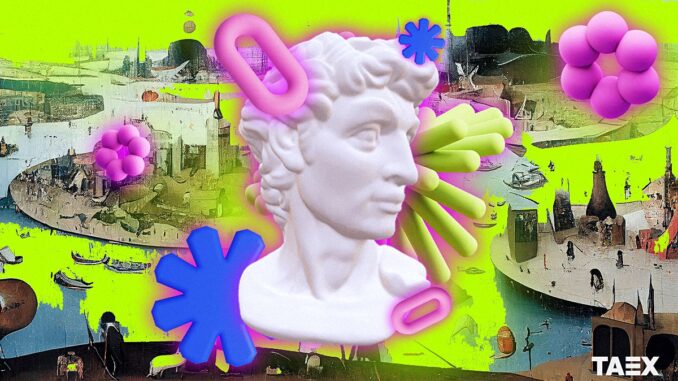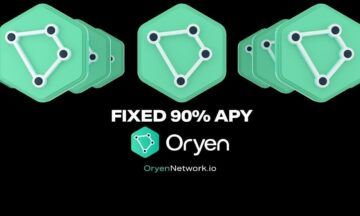
Since digitalization is becoming an unavoidable part of our everyday lives, artists are also gradually moving away from painting and becoming interested in working in numbers, creating works that are sold in the form of NFTs.
In response to this phenomenon, companies such as TAEX come to light – TAEX is an organization that believes in the future of NFT art and helps to shape it by institutionalizing digital art by bringing together artists, curators, and collectors from this field.
Some would say that digital art is inanimate and lacks the aspect of being able to directly engage with art the way one could do it with physical objects. Even though the pandemic has contributed to the development of NFT art, a lot of people are not fully convinced.
This year, at Art Basel Paris, the emerging contemporary art platform TAEX presented a new drop by Lev Manovich on the Tezos blockchain. A collaboration between such an established artist as Lev Manovich and a company such as TAEX is an incident truly worthy of attention.
Created in 1970 by gallerists from Basel, Art Basel has been staging the world’s premier art shows for modern and contemporary art, sited in Basel, Miami Beach, and Hong Kong.
The occasion of TAEX being invited to join this year’s show is very important, not just for the world of NFTs, but also for the contemporary art scene, in general. NFT art is still perceived as something ephemeral by many in the creative field.
It is impossible to deny that NFTs have incredible prospects and the potential to capture a significant chunk of art transactions in the future. Technological innovation and cutting-edge computing are uplifting both visual artists and galleries.
The perception of art has been transforming over the post-pandemic period with new mediums, such as online virtual rooms, 3D models of exhibitions, and so on. For most of its existence, Art Basel has been focusing on representing traditional art forms, however, the post-epidemic world has evolved to a place where virtual reality is now becoming a bigger part of the art scene than it has ever been before and it is becoming evident that we should make room for new mediums.
TAEX represents the new wave of artistic communities that marry together contemporary art and NFTs and being provided with a platform by Art Basel serves as a token of acceptance and trust in the future of digital art.
TAEX is a curatorial platform that brings together contemporary art and web3. Working with artists and curators with institutional careers, TAEX successfully introduces them to the world of NFT and explores the medium of blockchain, also offering an interdisciplinary platform for artists, curators, and collectors to discuss, showcase and sell crypto art.
The focus of the company is bringing together experts from various fields and introducing new artists and their approaches to each other, as well as to the rest of the world. As the website of the company states: “We believe in a critical outlook on the theory and practice of digital art, NFT technology and the Metaverse, while providing professional and comprehensive insights and opinions”.
Earlier this year, TAEX partnered up with the Art Newspaper International, Christie’s Education, and Decentraland and continues to expand both their pool of partners and their community of artists. It is also important to mention that TAEX is more of a contemporary art platform than an NFT marketplace, constantly working on bringing in new artists, collectors, curators, brands, and influencers.
Earlier this October, TAEX took part in the Art Basel Paris, facilitating an open discussion and a private event for members of the TAEX community. However, the main achievement of TAEX over the span of Art Basel was the presentation of their latest drop with Dr. Lev Manovich – a digital culture theorist, writer, and artist whose work has changed how we think about media and technology today.
Lev Manovich was born in Moscow, where he studied fine arts, architecture, and computer programming. He moved to New York in 1981, receiving an M.A. in Visual Science and Cognitive Psychology and a Ph.D. in Visual and Cultural Studies from the University of Rochester.
Manovich has been working with computer media as an artist, computer animator, designer, and programmer since 1984. His digital art projects were shown in over 110 group and personal exhibitions worldwide. The lab’s projects were commissioned by MoMA, New Public Library, and Google.
His work ‘Selfiecity’ won a Golden Award in the Best Visualization Project category in the global competition in 2014. In 2013, Manovich appeared in the ‘List of 25 People Shaping the Future of Design (Complex) and in the following year (2014) he was included in the list of ‘50 most interesting people building the future (The Verge).
Today, Dr. Lev Manovich is a Presidential Professor at The Graduate Center, City University of New York, and founder and director of the Cultural Analytics Lab. Recognized as one of the most influential voices in contemporary media theory, Dr. Manovich’s work is essential reading for anyone interested in understanding the role of technology in contemporary society.
For the drop presented at Art Basel Paris, Lev Manovich collaborated with curator Margarita Kuleva. They have previously worked together and did it again splendidly. This serves as a perfect example of how creatives from different fields are brought together by organizations, such as TAEX to create beautiful new things together.
When talking about digital art and how drops such as this one are created it is important to not underestimate the value of the curator, who sees the process through and brings it to the world in its final form. Dr. Margarita Kuleva is a researcher, curator, and artist.
Her main point of interest is exploring social inequalities in culture and technology. She is a 2022-2023 postdoctoral researcher at NYU Jordan center, where, in her research and art projects, she mainly used ethnography and performance. In particular, her Ph.D. was dedicated to the “behind the scenes” of cultural institutions to give greater visibility to the invisible workers of culture.
She has previously worked with several international cultural institutions, including Manifesta Biennale, Boston Center for the Arts, Goethe Institute, Street Art Museum, and more.
The following text about the drop was written by Dr. Kuleva, who curated this project:
“The exclusive drop for Art Basel is a collaborative effort of two artists and researchers — Lev Manovich and Margarita Kuleva. The collaboration stems from Lev’s ongoing experiments with ‘Midjourney’ and inquiry into the vantage points, limitations and learning language of AI. Together, Manovich and Kuleva ask a series of burning questions about the AI’s artistic production, agency, authorship and the ways they transform the art world, market and, most importantly — artistic labor.
Manovich’s series is a conceptual work based on an artificial intelligence perspective on art history. No coincidence that the drop’s title reproduces exactly the phrase that was used as a ‘MidJourney’ request to create one of the works for the drop. The resulting ultra-detailed series, at first glance, directly refers to Bosch and Brueghel, but a more careful study will allow one to notice modernist architectural and avant-garde aesthetic elements inscribed in the landscape.
Using AI algorithms as a co-author and tool of work, Manovich remains true to his artistic language. Combining bold experiments with new technologies, visual richness and interest in cities as systems, this series consistently continues Manovich’s iconic projects as ‘Soft Cinema’, ‘On Broadway’ and ‘Selfiecity’. *New technologies have always changed the arts — both the subjects, aesthetics and cannons.
Similar to the rediscovery of linear perspective during the Renaissance or 19th century invention of photography and oil paint tubes, into the 20th century, computer and digital evolution, new technologies like blockchain and AI Image synthesis, will impact the visual arts. Does AI disrupt the agency of artistic originality? What is the artistic viewpoint of AI? These are some of the topics proposed for the discussion, in relation to history of art, history of computing and posthumanist anthropology.”
TAEX, TEZOS, Dr. Manovich, and Dr. Margarita Kuleva collaborated, creating a drop that was presented at Art Basel in Paris. It is a perfect example of conjoint effort coming from professionals who believe in the future of NFT and are willing to facilitate its future in the world of art.
NFTs presented in the drop can be seen as more than just part of a collection or something of value in terms of emotional experience or nostalgia, but also as an opportunity to show off a unique acquisition. As a society, we are just starting to work on the topics that this drop is inviting us to investigate.
It also invites people who are extremely intelligent and versed in finance. Technology and art are currently experimenting to look at new ways in which AI and computing can be used to assess our reality.
Collaborations like this not only carry an artistic purpose within them but also help blockchains, cryptocurrencies and tokens to take their rightful part in our future.
Companies such as TAEX and TEZOS are working hard to transform the perception of media art. It may seem pointless to some to own an “image file” rather than a true work of art or a picture of a Nike shoe rather than a physical shoe.
To change opinions, it is also important to create a language that would make digital art more transparent and approachable for those who are just starting to warm up to this new form. This is why TEZOS also created the ‘Tezos Speaker Series’ that was held over a three-day span of Art Basel.
There, a comprehensive introduction into the world of blockchain art was presented to the audience, alongside with a discussion on art activism on-chain. Together with other leading generative artists, curators and collectors, Dr. Manovich took part in the panel, where he spoke about art, web3, and collecting.
As Dr. Manovich stated: “Algorithmic / generative is not only a method for art making. It is also a method for publishing artworks (which can, for example, evolve over time, as some art NFTs do), collecting, curating, exhibiting, and writing about this art.
By separating these areas and thinking about how algorithms can be used in each of them – in similar or unique ways – we will innovate. Certainly, there are already some examples of algorithmic curating, but other potential areas, such as art collecting and also planning and structuring exhibitions still have not been touched.”
Even though the panel was held as a side event, it is important to recognize how valuable these conversations are in the process of shifting our understanding of new media art and how much TEZOS is doing to bring this understanding closer to its audience.
There is no doubt about the fact that the future of crypto art is still full of uncertainties. However, gradually, society is starting to drift away from giving value to physical objects and many come to understand that they can create these values themselves and transform their own perception of art.
This also applies to creatives. Given that crypto-collectors and crypto-artists are fundamentally different from traditional collectors and artists, we are witnessing the birth of the “new stars” in the NFT community and the formation of a new art market.
Art will always go in line with humanity and, right now, we are getting deeper and deeper into the digital world. Companies such as TAEX and TEZOS help us transcend physical boundaries and create spaces that never existed. They recognize that the web is a key technology that has brought us global change and change always gives art an explosion of new possibilities taking us into the future. Or could it be that the future is already here?
The future is already here.
Find Out More Here:
Check out the Drop by Manovich | TAEX Website
Disclaimer
All the information contained on our website is published in good faith and for general information purposes only. Any action the reader takes upon the information found on our website is strictly at their own risk.











Be the first to comment